JSF Datepicker Example
Hello, in this tutorial we will implement the datepicker component in jsf and we will use bootstrap – a responsive CSS framework to demonstrate the following,
- Registration Form
- Sending and retrieving data to and from a managed bean and using the same in output page
This example will show how to integrate and implement the datepicker module in a jsf enabled form.
1. Introduction
A datepicker is an interactive dropdown that makes it easy to choose the date from a calendar instead of typing it manually. It’s a great way to avoid user errors because a user can see the corresponding day of the week for each date. Plus, it gives the form a little extra interactive shine!
We will have the following components in our application:
- Registration Bean – Managed bean class for the registration form
- input.xhtml – Contains the registration form
- output.xhtml – Contains a tabular structure to display the registration form result
- formatDatePicker.js – Contains the datepicker javascript code
- web.xml – Web application configuration file
But before we create the application let’s take a look at the datepicker utility.
1.1 Datepicker Plugin
Datepickers in jQueryUI allow users to enter dates easily and visually. Developers can customize the date format, restrict the selectable date ranges and add in buttons & other navigation options easily.
jQueryUI provides datepicker() method that creates a datepicker and changes the appearance of HTML elements on a page by adding new CSS classes. Transforms the input, div and span elements in the wrapped set into a datepicker control.
1.2 Datepicker Syntax
The datepicker() method can be used in two forms:
$(selector, context).datepicker (options)method$(selector, context).datepicker ("action", [params])method
The datepicker’s options() method declares that an input element (or div or span) depending on how the developer chooses to display the calendar, should be managed as a datepicker.
The options parameter is an object that specifies the behavior and appearance of the datepicker elements. If the developer wants to use a wide range of options they might use this option.
1.3 Datepicker Pre-requisites
To create and enable the datepicker component in jsf, developers will need the following prerequisites:
- jQuery 1.x – This popular JavaScript library is needed by the date picker
- Bootstrap 3.x – The datepicker works with bootstrap in order to enhance the user experience and make it more interactive
After adding the prerequisites, the header of the file should look something like this:
sample.xhtml
<!-- DatePicker JavaScript & CSS --> <script type="text/javascript" src="https://examples.javacodegeeks.com/wp-content/litespeed/localres/aHR0cHM6Ly9jb2RlLmpxdWVyeS5jb20vjquery-1.12.4.js" /> <script type="text/javascript" src="https://examples.javacodegeeks.com/wp-content/litespeed/localres/aHR0cHM6Ly9jb2RlLmpxdWVyeS5jb20vui/1.12.1/jquery-ui.js" /> <link rel="stylesheet" href="https://examples.javacodegeeks.com/wp-content/litespeed/localres/aHR0cHM6Ly9jb2RlLmpxdWVyeS5jb20vui/1.12.1/themes/base/jquery-ui.css" />
Now, open up the Eclipse IDE and let’s start building the application.
1.4 Datepicker Implementation
In order to use the datepicker component, we will have to add the below jQuery code in the script tag so that component can be initialized at the page load,
jQuery Code
$(document).ready(function() {
$(".datepicker").datepicker({
dateFormat: 'dd MM, yy',
changeMonth: true,
changeYear: true,
yearRange: "1960:2017"
});
});In order to ensure jsf best practices, we will include this code in a javascript file by using the h:outputScript tag in the file. Let’s take a look at the sample code below,
sample.xhtml
<h:outputScript library="js" name="formatDatePicker.js" />
2. JSF Datepicker Example
2.1 Tools Used
We are using Eclipse Kepler SR2, JDK 8 (1.8.0_131), Tomcat7 application server. Having said that, we have tested the code against JDK 1.7 and it works well.
2.2 Project Structure
First, let’s review the final project structure, in case you are confused about where you should create the corresponding files or folder later!

2.3 Project Creation
The below example shows how to implement datepicker in a sample form application. With datepicker and bootstrap classes the magic happens where the boring looking form turns into a beautiful layout with all the CSS classes already applied.
This section will demonstrate on how to create a Dynamic Web Java project with Eclipse. In Eclipse IDE, go to File -> New -> Dynamic web project
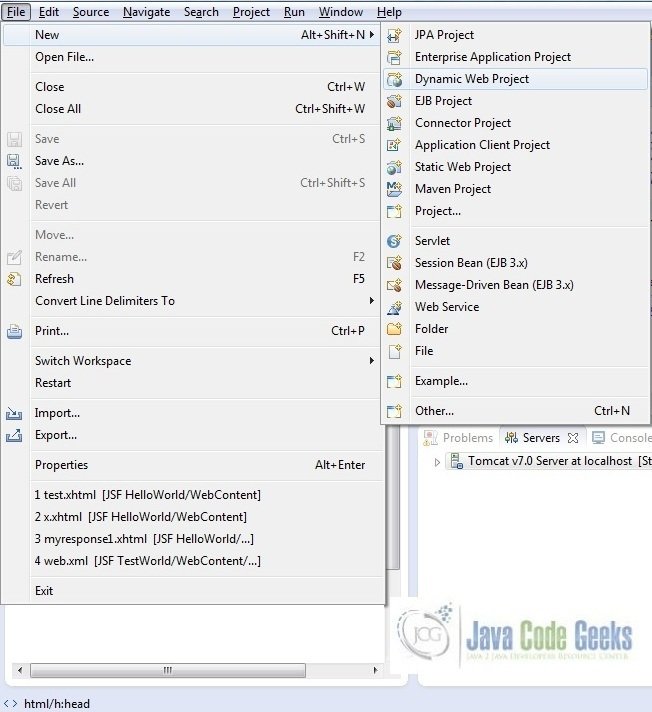
In the New Dynamic Project window fill in the below details and click next
- Enter the project name and project location
- Select Target runtime as Apache Tomcat v7.0 from dropdown
- Select Configuration as JavaServer Faces v.2.2 Project from dropdown (this is required to download the java server faces capabilities in your project)
Leave everything as default in this window as we will be making the required java file at a later stage. Simply click next and we will land up on the web-module window
In the Web Module window, leave the context_root and content_directory values as default (however, you can change the context_root but for the first application let’s keep it as a default value). Simply, check Generate web.xml deployment descriptor checkbox and click next
In the JSF Capabilities windows, we will require downloading the dependencies (not available by default) so that our project is configured as a JSF module in Eclipse. Add the JSF capabilities to the web project by clicking on the download icon (encircled in fig. 5) and download the JSF 2.2 Mojarra implementation

A new pop-up window will open where it will auto lists down the JSF library. Select the JSF 2.2 library and click next (the library name and download destination will be auto populated)
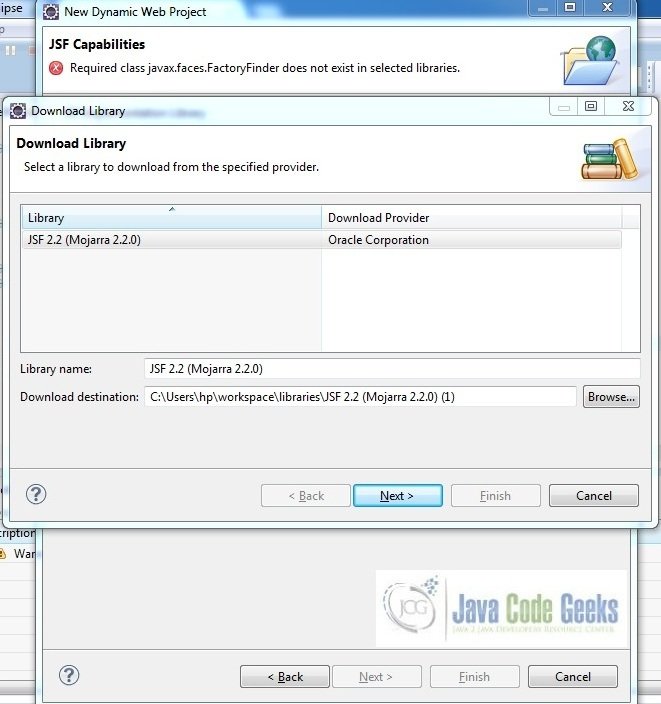
Check the license checkbox and click finish. Eclipse will download the JSF 2.2 library and will display them on the JSF capabilities windows (i.e. Fig. 6)

Now the JSF implementation libraries will be listed down on the capabilities page. Select the checkbox (JSF2.2 (Mojarra 2.2.0)) and leave everything else as default. Click Finish
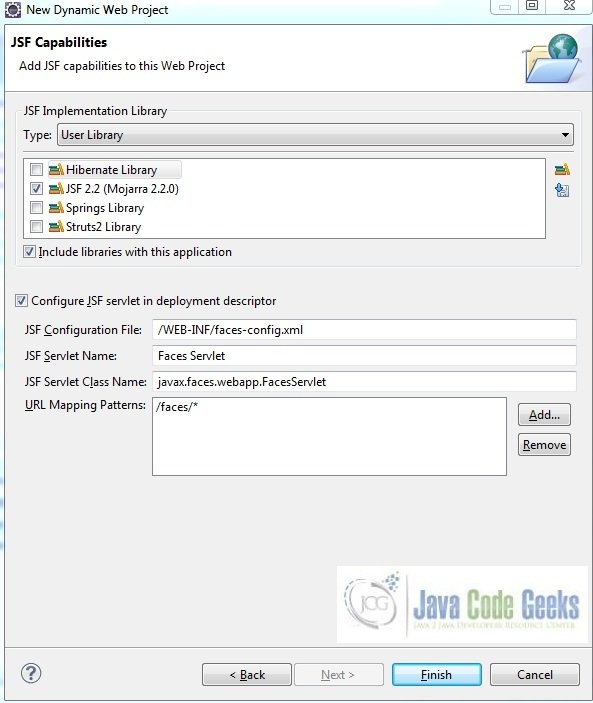
Eclipse will create the project named JSF Datepicker in the workspace and web.xml will be configured for accepting the JSF requests. It will have the following code:
web.xml
<?xml version="1.0" encoding="UTF-8"?> <web-app xmlns:xsi="http://www.w3.org/2001/XMLSchema-instance" xmlns="http://java.sun.com/xml/ns/javaee" xsi:schemaLocation="http://java.sun.com/xml/ns/javaee http://java.sun.com/xml/ns/javaee/web-app_3_0.xsd" id="WebApp_ID" version="3.0"> <display-name>JSF Datepicker</display-name> <welcome-file-list> <welcome-file>index.html</welcome-file> <welcome-file>index.htm</welcome-file> <welcome-file>index.jsp</welcome-file> <welcome-file>default.html</welcome-file> <welcome-file>default.htm</welcome-file> <welcome-file>default.jsp</welcome-file> </welcome-file-list> <servlet> <servlet-name>Faces Servlet</servlet-name> <servlet-class>javax.faces.webapp.FacesServlet</servlet-class> <load-on-startup>1</load-on-startup> </servlet> <servlet-mapping> <servlet-name>Faces Servlet</servlet-name> <url-pattern>/faces/*</url-pattern> </servlet-mapping> <context-param> <description>State saving method: 'client' or 'server' (=default). See JSF Specification 2.5.2</description> <param-name>javax.faces.STATE_SAVING_METHOD</param-name> <param-value>client</param-value> </context-param> <context-param> <param-name>javax.servlet.jsp.jstl.fmt.localizationContext</param-name> <param-value>resources.application</param-value> </context-param> <listener> <listener-class>com.sun.faces.config.ConfigureListener</listener-class> </listener> </web-app>
Now let’s start building the application!
3. Application Building
Following are the steps involved in developing this application:
3.1 Source File Creation
For the demo, we will have an input file containing the registration form and an output file displaying the form result. Right click on project WebContent -> New -> File
Note – In JSF 2.0, it’s recommended to create a JSF page in xhtml format, a file format with .xhtml extension
A pop-up window will open, verify the parent folder location as JSF Datepicker/WebContent and enter the file name (input.xhtml) and click Finish
Repeat the step where we need to create the file for our application (i.e. fig. 10). Again, verify the parent folder location as JSF Datepicker/WebContent and enter the filename (output.xhtml) and click Finish
3.1.1 Implementation of Input & Output file
Here in the input.xhtml, we will have the form based UI components and will add the code to evoke the datepicker module on page load. The action attribute on the button will show the result based on the navigation logic written in createRegistrationForm(). Add the following code to it:
input.xhtml
<!DOCTYPE HTML>
<html lang="en" xmlns="http://www.w3.org/1999/xhtml"
xmlns:h="http://java.sun.com/jsf/html">
<h:head>
<meta charset="utf-8" name="viewport" content="width=device-width, initial-scale=1" http-equiv="X-UA-Conpatible" />
<!-- DatePicker JavaScript & CSS -->
<script type="text/javascript" src="https://examples.javacodegeeks.com/wp-content/litespeed/localres/aHR0cHM6Ly9jb2RlLmpxdWVyeS5jb20vjquery-1.12.4.js" />
<script type="text/javascript" src="https://examples.javacodegeeks.com/wp-content/litespeed/localres/aHR0cHM6Ly9jb2RlLmpxdWVyeS5jb20vui/1.12.1/jquery-ui.js" />
<link rel="stylesheet" href="https://examples.javacodegeeks.com/wp-content/litespeed/localres/aHR0cHM6Ly9jb2RlLmpxdWVyeS5jb20vui/1.12.1/themes/base/jquery-ui.css" />
<h:outputScript library="js" name="formatDatePicker.js" />
<h:outputStylesheet library="css" name="bootstrap.min.css" />
<title>JSF Datepicker Example</title>
<style type="text/css">
.col-xs-updated {
width: 92% !important;
}
</style>
</h:head>
<h:body>
<div class="container">
<div class="nav navbar-nav">
<div class="navbar-brand">JSF Datepicker</div>
</div>
<div class="row">
<div class="col-xs-12 col-xs-updated">
<h:form id="registrationForm" styleClass="form-horizontal">
<div class="form-group">
<h:outputLabel value="First Name" styleClass="control-label col-sm-2" />
<div class="col-sm-10">
<h:inputText value="#{registrationBean.firstName}" styleClass="form-control" />
</div>
</div>
<div class="form-group">
<h:outputLabel value="Last Name" styleClass="control-label col-sm-2" />
<div class="col-sm-10">
<h:inputText value="#{registrationBean.lastName}" styleClass="form-control" />
</div>
</div>
<div class="form-group">
<h:outputLabel value="DOB" styleClass="control-label col-sm-2" />
<div class="col-sm-10">
<h:inputText value="#{registrationBean.dateOfBirth}" styleClass="form-control datepicker" />
</div>
</div>
<div class="form-group">
<div class="col-sm-offset-2 col-sm-10">
<h:commandButton value="Create" action="#{registrationBean.createRegistrationForm}" styleClass="btn btn-primary" />
</div>
</div>
</h:form>
</div>
</div>
</div>
</h:body>
</html>In the output page, JSF will display the #{registrationBean.firstName}, #{registrationBean.lastName}, #{registrationBean.dateOfBirth} properties value which you will enter in the input page. Add the following code to it:
output.xhtml
<!DOCTYPE HTML>
<html lang="en" xmlns="http://www.w3.org/1999/xhtml"
xmlns:h="http://java.sun.com/jsf/html">
<h:head>
<meta charset="utf-8" name="viewport" content="width=device-width, initial-scale=1" http-equiv="X-UA-Conpatible" />
<link rel="stylesheet" href="https://examples.javacodegeeks.com/wp-content/litespeed/localres/aHR0cHM6Ly9tYXhjZG4uYm9vdHN0cmFwY2RuLmNvbS8=bootstrap/3.3.7/css/bootstrap.min.css" />
<title>JSF Datepicker Example</title>
<style type="text/css">
.tableOutput {
margin: 12px;
width: 98% !important;
}
.tab {
display: inline-block;
margin-left: -2px;
}
</style>
</h:head>
<h:body>
<div class="container">
<div class="nav navbar-nav">
<div class="navbar-brand">JSF Datepicker</div>
</div>
<table class="table table-bordered table-striped tableOutput">
<thead>
<tr>
<th>Name</th>
<th>Date Of Birth</th>
<th></th>
</tr>
</thead>
<tbody>
<tr>
<td><h:outputText value="#{registrationBean.firstName}" /> <span class="tab"><h:outputText value="#{registrationBean.lastName}" /></span></td>
<td><h:outputText value="#{registrationBean.dateOfBirth}" /></td>
<td><a href="#"><span class="glyphicon glyphicon-trash" /></a></td>
</tr>
</tbody>
</table>
</div>
</h:body>
</html>3.2 Java Class Creation
Let’s create the required java files. Right click on src folder New -> Package
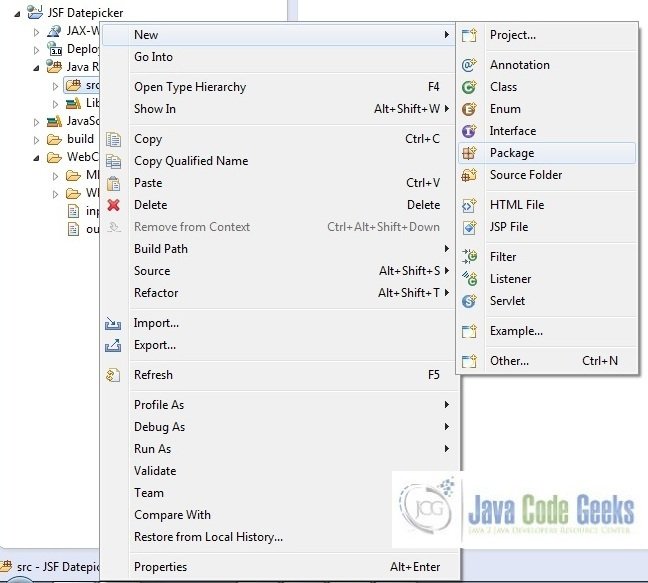
A new pop window will open where we will enter the package name, namely com.jsf.datepicker
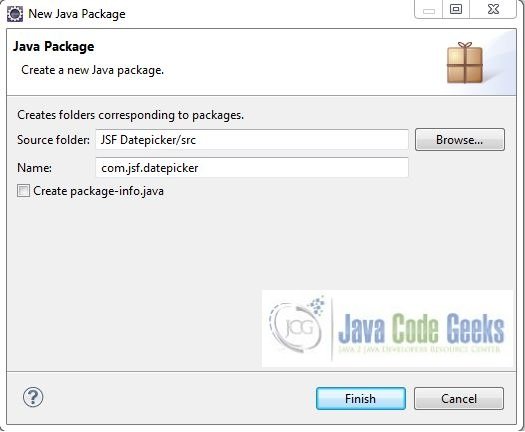
Once the package is created in the application, we will need to create the required managed bean class. Right click on the new create package New -> Class
A new pop window will open and enter the file name as RegistrationBean. The bean class will be created inside the package – com.jsf.datepicker
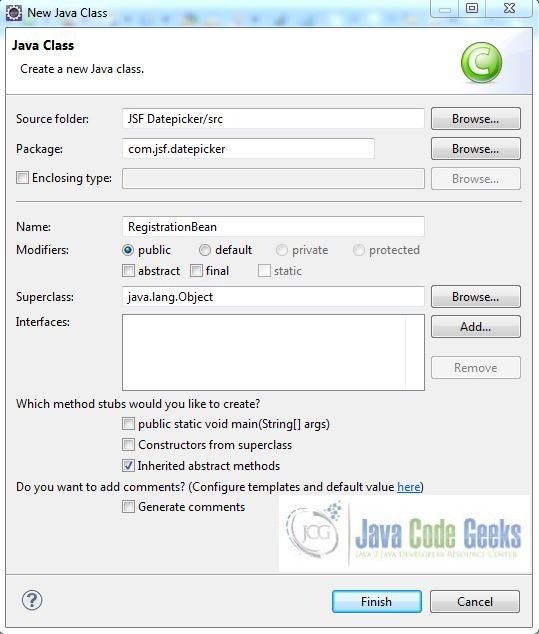
This class has a method createRegistrationForm() method which interacts with create action event and display the result on the output page in a tabular form. Add the following code to it:
RegistrationBean.java
package com.jsf.datepicker;
import javax.faces.bean.ManagedBean;
import javax.faces.bean.SessionScoped;
@ManagedBean @SessionScoped
public class RegistrationBean {
private String lastName;
private String firstName;
private String dateOfBirth;
public String getLastName() {
return lastName;
}
public void setLastName(String lastName) {
this.lastName = lastName;
}
public String getFirstName() {
return firstName;
}
public void setFirstName(String firstName) {
this.firstName = firstName;
}
public String getDateOfBirth() {
return dateOfBirth;
}
public void setDateOfBirth(String dateOfBirth) {
this.dateOfBirth = dateOfBirth;
}
public String createRegistrationForm() {
System.out.println("Registration Form Details - Name: " + firstName + " " + lastName + ", DOB: " + dateOfBirth);
return "output";
}
}4. Project Deploy
Once we are ready with all the changes done, let us compile and deploy the application on tomcat7 server. In order to deploy the application on tomcat7, right-click on the project and navigate to Run as -> Run on Server
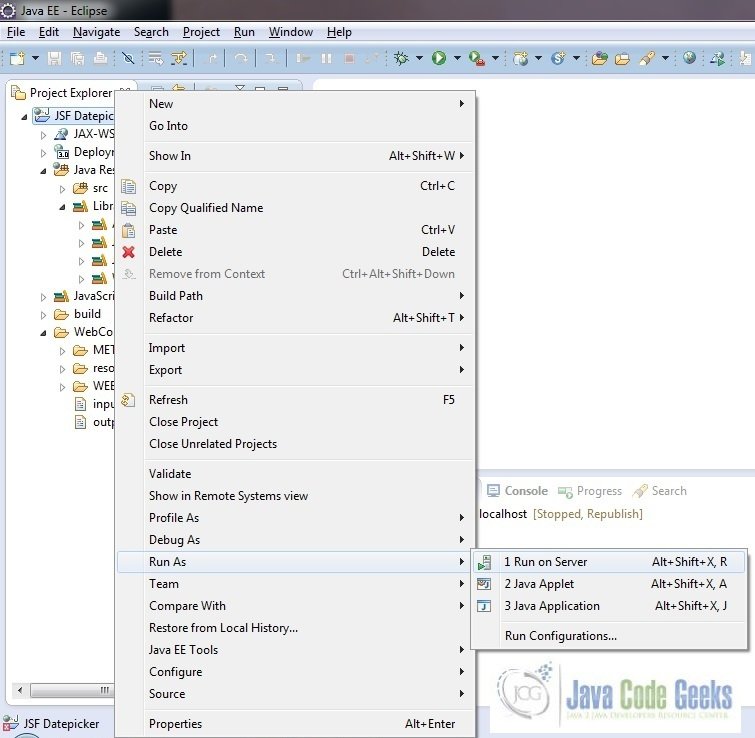
Tomcat will deploy the application in its webapps folder and shall start its execution to deploy the project so that we can go ahead and test it on the browser
Open your favorite browser and hit the following URL. The output page will be displayed.
http://localhost:8082/JSFDatepicker/faces/input.xhtml
Server name (localhost) and port (8082) may vary as per your tomcat configuration
5. Project Demo
When we will hit the application url, you will see the registration form page

Enter the First Name, Last Name, and DOB values and press the Create button
The output page will be displayed showing the entered details in a tabular format
Hope this helped :)
6. Conclusion
Through this example, we have learned about the integration of Bootstrap components in jsf and deploy it using the tomcat7 application server
7. Download the Eclipse Project
This was a JSF Datepicker example with Eclipse and Tomcat.
You can download the full source code of this example here: JSF Datepicker

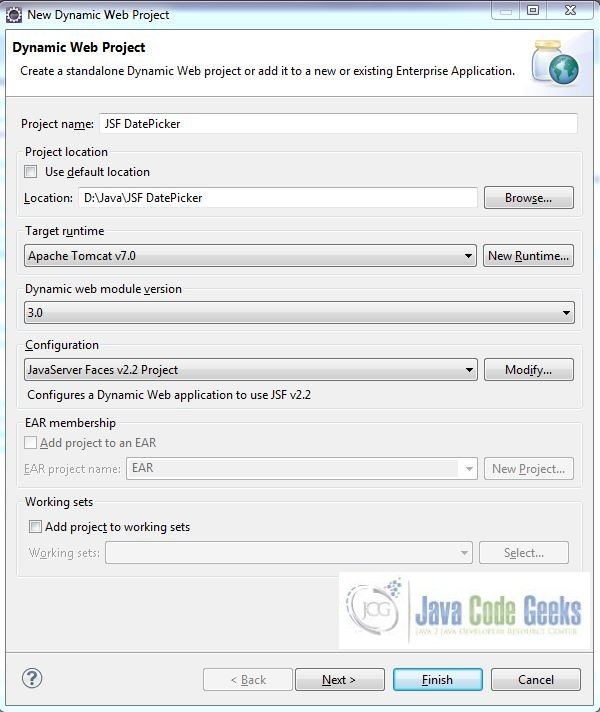
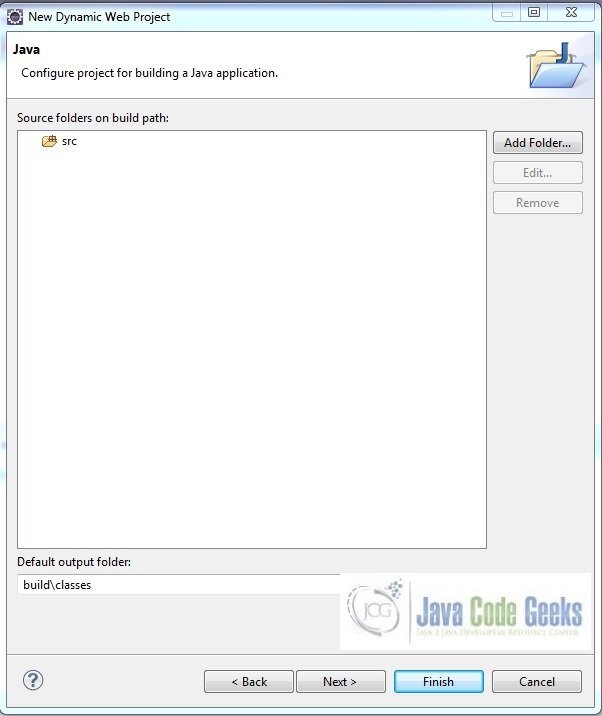
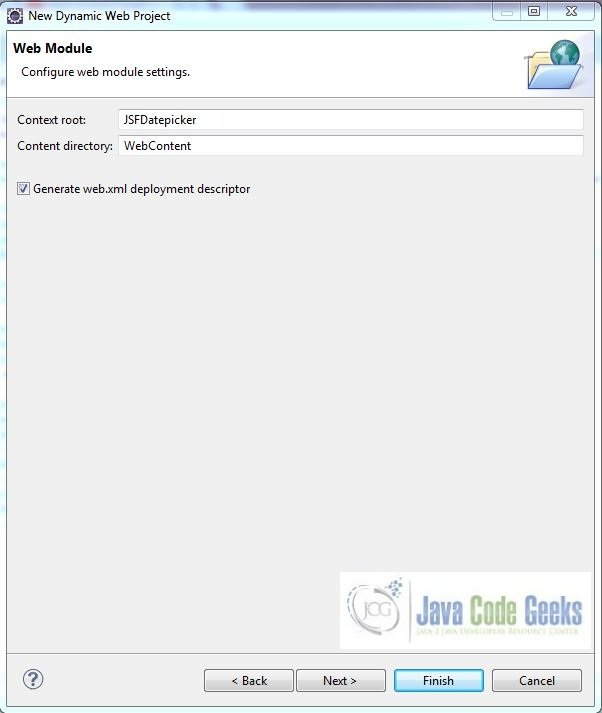

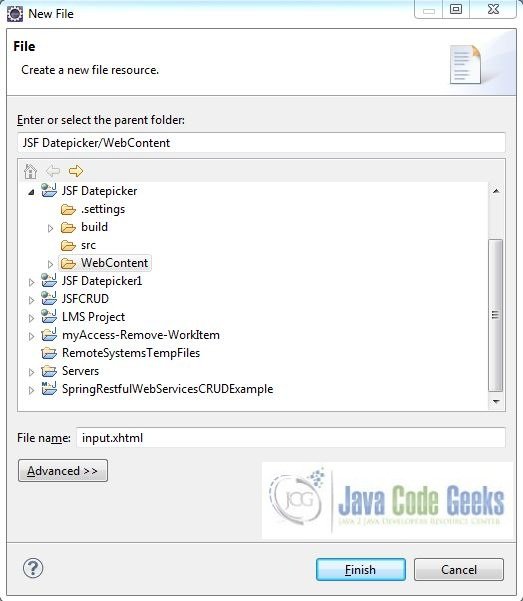
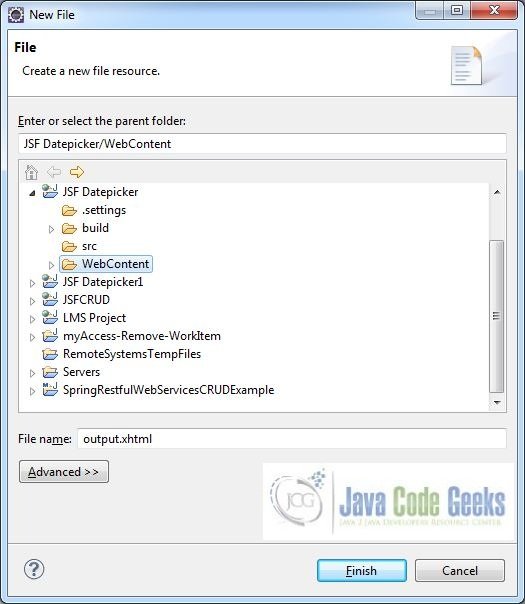



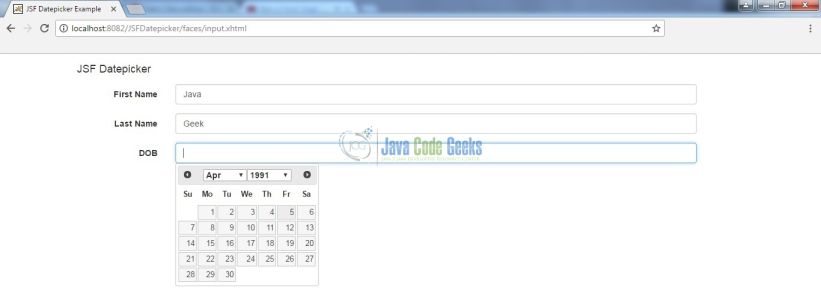


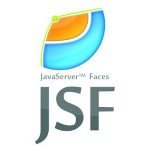
Hello
I was happy to find your code for the Date Picker. A feature missing in JSF which is otherwise a good framework.
Thanks